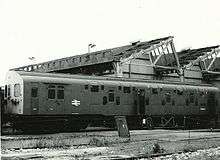SR Class 4DD
| Southern Railway 4-DD | |
|---|---|
 Class 4DD no 4902 in 1972 | |
| In service | 1949–1971 |
| Constructed | 1949 |
| Number built | 2 sets (8 cars) |
| Number preserved | 2 DMBTs |
| Number scrapped | 2 DMBTs, all TTs |
| Formation | DMBT-TT-TT-DMBT |
| Fleet numbers | see text |
| Capacity | 552 seated, 150 standing (per set) |
| Operator(s) | British Rail |
| Line(s) served | Charing Cross to Dartford |
| Specifications | |
| Train length | 257 ft 5 in (78.46 m) |
| Width | 9 ft 3 in (2.82 m) |
| Weight | 133 long tons 0 cwt (297,900 lb or 135.1 t) |
| Traction system | English Electric |
| Electric system(s) | 750 V DC |
| Current collection method | Third rail |
| Braking system(s) | Electro-pneumatic |
| Coupling system | Screw-link |
| Track gauge | 4 ft 8 1⁄2 in (1,435 mm) |

Conceived by Oliver Bulleid for the Southern Railway's commuter route from London Charing Cross to Dartford, the two 4DD electric multiple units were the only double-deck trains to run on the main line railway network in Britain. Whilst common in continental Europe and North America, the restrictive railway loading gauge in the United Kingdom prohibits normal double-deck cars with two fully separated decks.
Design
More split-level than truly double-deck (as the compartments were alternately high and low, to ensure that the overall height of the unit was within the clearances necessary to pass through tunnels and under bridges). Unusually for an "experiment" they lasted in traffic from 1949 to 1971, undergoing routine maintenance and repaints with no hiccups in their life. Near the end, they were renumbered 4901 and 4902. 4001 and 4002 were reassigned to another pair of prototype southern region 4-car EMUs, the 4-PEPs.
Disadvantages
The 4DD was somewhat unsuccessful because the upper level compartments were cramped and poorly ventilated (the upper level windows could not be opened due to tight clearance). The compartments were pressure-ventilated but the equipment proved to be troublesome. Dwell times at stations were lengthened because of the increase in the number of passengers per door. To obtain the extra seating capacity that was being sought, it was instead decided to lengthen trains from eight cars to ten.
Formations
| Unit Numbers | DMBT | TT | TT | DMBT | Notes | |
|---|---|---|---|---|---|---|
| Initial number | Final Number | |||||
| 4001 | 4901 | 13001 | 13501 | 13502 | 13002 | (built September 1949) |
| 4002 | 4902 | 13003 | 13503 | 13504 | 13004 | (built October 1949) |
Preservation
Driving motor cars 13003 and 13004 survive, the former at Kent Locomotives Ltd - Sellindge, Kent,[1] and the latter at the Northamptonshire Ironstone Railway Trust.[2] One trailer was also preserved, but it was scrapped when Ashford Steam Centre closed in 1984, in lieu of rent owed.[3] Driving motor car 13003 is now in the care of Bulleid 4-DD Double Deck EMU Group, which plans to restore it.[1]
References
- 1 2 "SR 13003 4-DD 'Double Decker' Driving Motor Brake Third built 1949". Vintage Carriages Trust. Retrieved 1 November 2017.
- ↑ "SR 13004 4-DD 'Double Decker' Driving Motor Brake Third built 1949". Vintage Carriages Trust. Retrieved 1 November 2017.
- ↑ Bright, Thomas (3 November 2017). "'O1' saviour Esmond Lewis-Evans dies". Steam Railway. Peterborough: Bauer Consumer Media (457): 18. ISSN 0143-7232.
Marsden, Colin J. (1983). Southern Electric Multiple-Units 1898–1948. Shepperton, Surrey: Ian Allan Limited. pp. 85–88. ISBN 0-7110-1253-9.